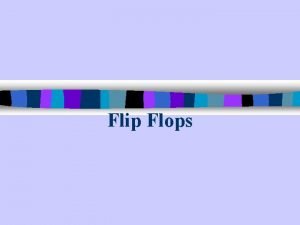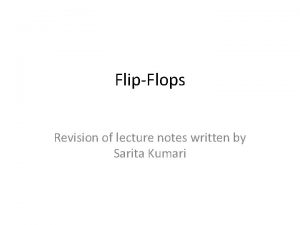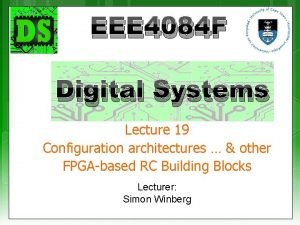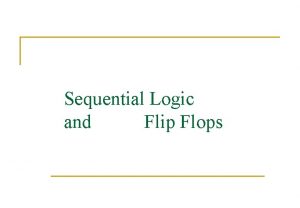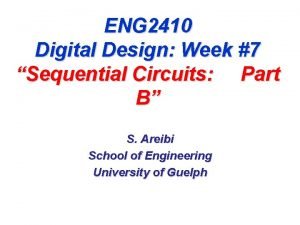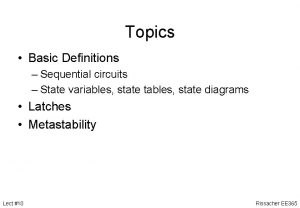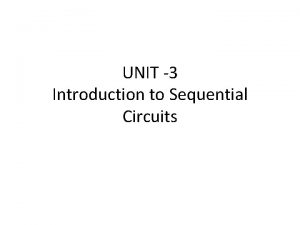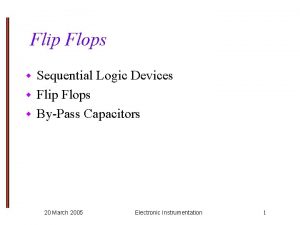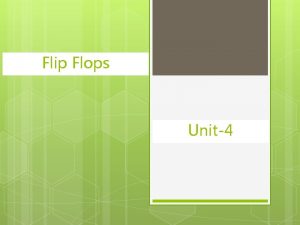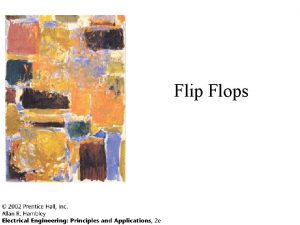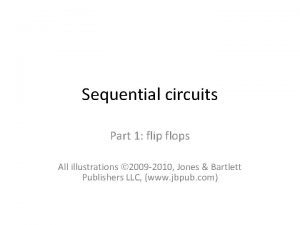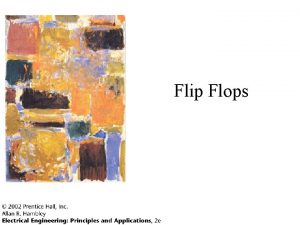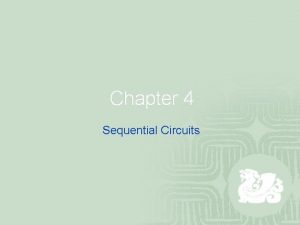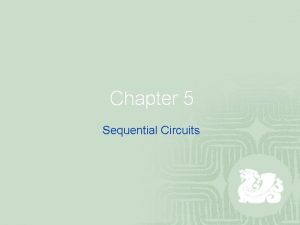Sequential Circuits Flip Flops 1 Flip Flops A











- Slides: 11

Sequential Circuits Flip Flops 1

Flip Flops § A flip-flop is a one bit memory that is edge-triggered or edge-sensitive memory element which means it active only at transitions; i. e. either from 0 1 or 1 0 § The flip-flop is at a “set state” if it forces the output to logic 1 and it is at a “reset state” if it forces the output to logic 0. level positive (rising) edge negative (falling) edge 2

Set Reset Flip-Flop (SR FF) • Two cross coupled NAND gates. • Two inputs S and R. • C is a control input (enable) to determine when the state of the filp-flop can be changed. S R Q C SR FF Q Q C R S Q C S R Qn+1 0 X X No change 1 0 0 No change 1 0 Reset state 1 1 0 1 Set state 1 1 1 Undefined 3

Now we will study the case when we suppose we have two cases for the present state and then apply the inputs. SR d ≡ don’t care 10 0 d 1 0 d 0 01 Excitation Table Present state Qn The State diagram S R Next state Qn+1 0 0 0 1 1 0 1 1 1 1 0 x 1 1 1 x No change Reset state Set state Not allowed 4

To get the next state Q n +1 R S Qn 0 1 0 0 1 1 x x Then Boolean Expression is Q n +1 = S + Qn 5

D flip-flop • D flip-Flop is designed to eliminate the undefined state in the SR FF When (S=R=1). D C D Qn+1 0 X No change 1 0 0 Reset state 1 1 1 Set state Q C D FF Q D Q C Q 6

To study the case when we consider that we have two cases for the present state and then apply the inputs: CD 11 0 d, 10 Excitation Table 0 C D Qn Qn+1 0 x 0 0 0 x 1 1 1 0 0 0 1 0 1 1 1 1 1 0 d, 11 1 10 Hold The State diagram Reset Set 7

D C Qn 1 1 1 Qn+1 = CD + 1 Qn When the FF is enabled, C = 1 Qn+1 = 1. D + 0. Qn = D 8

JK Flip-Flop • It is similar to SR with J replaced by S and K replaced by R except for undefined state. J J K Qn+1 0 0 No change 0 1 0 Reset state 1 0 1 Set state 1 1 Complement K Q C JK FF Q Toggle 9

To study the case when we suppose that we have two cases for the present state and then apply the inputs: JK 10, 11 Excitation Table d 0 0 d J K Qn Qn+1 0 0 0 1 1 0 0 1 1 0 0 0 1 1 1 Set state 1 1 0 Toggle 1 0 01, 11 Hold The State diagram Reset state K J Qn 1 1 Qn+1 = 1 1 Qn + J 10

T Flip-Flop It is equivalent to JK FF with input J= K=T T Excitation Table T Qn+1 0 Qn 1 Q C No change T FF Q Complement Since it is equivalent to Jk, we can use the same characteristic equation to find the next state: Qn+1 = Qn + J = Qn + T 11



